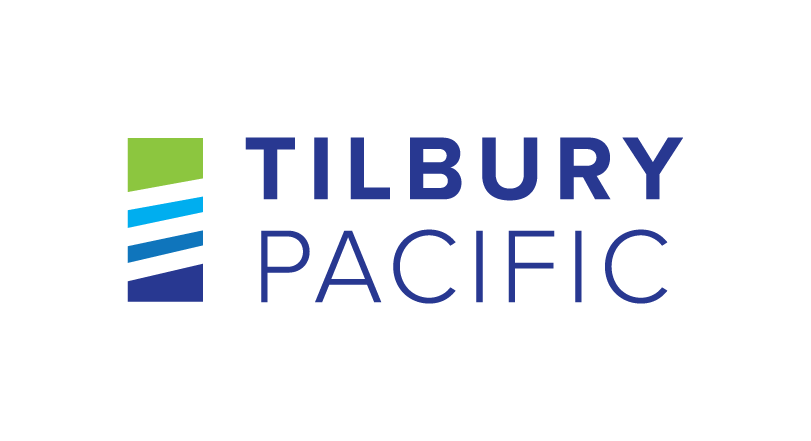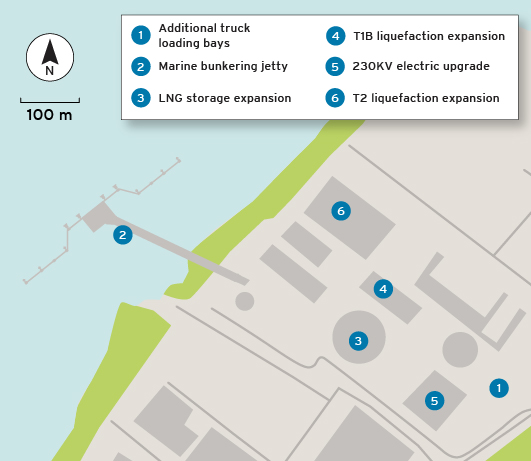ABOUT TILBURY PACIFIC
Project summary
The Tilbury Pacific marine jetty will supply liquified natural gas (LNG) bunkering vessels for refueling services in the Port of Vancouver helping to reduce overall carbon emissions by attracting newer, cleaner marine vessels to our West Coast ports.
The jetty is strategically located next to FortisBC’s Tilbury LNG storage facility which leverages British Columbia’s abundant natural resources and produces approximately 30 per cent less carbon-intensive LNG compared to similar LNG facilities around the world.
Who we are
Tilbury Jetty Limited Partnership is the proponent of the Tilbury Pacific Marine Jetty Project, an affiliate of FortisBC Holdings Inc. FortisBC is a well-established business in British Columbia, and brings decades of experience in British Columbia-based LNG operations to the Tilbury Pacific Marine Jetty Project.
What we want to achieve
Tilbury Pacific positions B.C. to play a leading role in the global shift to lower emissions energy choices. Specifically, it could supply local ships and ocean-going vessels that are switching to LNG as fuel.
What we’re proposing to build
- Marine jetty with berthing and mooring facilities
- Access trestle connecting to the shoreline
- LNG line linking to FortisBC’s Tilbury LNG facility
- Vapour return line, water supply and other utilities
Project location
ABOUT TILBURY PACIFIC
Project summary
The Tilbury Pacific marine jetty will supply liquified natural gas (LNG) bunkering vessels for refueling services in the Port of Vancouver helping to reduce overall carbon emissions by attracting newer, cleaner marine vessels to our West Coast ports.
The jetty is strategically located next to FortisBC’s Tilbury LNG storage facility which leverages British Columbia’s abundant natural resources and produces approximately 30 per cent less carbon-intensive LNG compared to similar LNG facilities around the world.
Who we are
Tilbury Jetty Limited Partnership is the proponent of the Tilbury Pacific Marine Jetty Project, an affiliate of FortisBC Holdings Inc. FortisBC is a well-established business in British Columbia, and brings decades of experience in British Columbia-based LNG operations to the Tilbury Pacific Marine Jetty Project.
What we want to achieve
Tilbury Pacific positions B.C. to play a leading role in the global shift to lower emissions energy choices. Specifically, it could supply local ships and ocean-going vessels that are switching to LNG as fuel.
What we’re proposing to build
- Marine jetty with berthing and mooring facilities
- Access trestle connecting to the shoreline
- LNG line linking to FortisBC’s Tilbury LNG facility
- Vapour return line, water supply and other utilities
Project location
![]() Image: Tilbury Pacific – Project Rendering
Image: Tilbury Pacific – Project Rendering

PROJECT TIMELINE
![]() Image: Tilbury Pacific – Project Rendering
Image: Tilbury Pacific – Project Rendering
On July 3, 2024, The Government of Canada issued a positive decision for the Tilbury Marine Jetty project. With the provincial environmental assessment certificate awarded on March 27, these two approvals allow the project to move forward in securing the necessary remaining approvals and permits for the project. As the detailed design and construction plans and additional permitting process proceeds, we will develop more clarity around the service date. The below timeline includes anticipated dates of future activities, and these may be subject to change. Visit our news page for updates.
PROJECT TIMELINE
On July 3, 2024, The Government of Canada issued a positive decision for the Tilbury Marine Jetty project. With the provincial environmental assessment certificate awarded on March 27, these two approvals allow the project to move forward in securing the necessary remaining approvals and permits for the project. As the detailed design and construction plans and additional permitting process proceeds, we will develop more clarity around the service date. The below timeline includes anticipated dates of future activities, and these may be subject to change. Visit our news page for updates.


WHY WE CHOSE TILBURY
We chose this site because it is a former industrial site next door to FortisBC’s Tilbury LNG facility. In operation since 1971, the facility already has the ability to produce LNG, which means our project will have a smaller physical footprint. The site also features a few other advantages:
It’s just 21 km from the mouth of the Fraser River, in an industrial area with existing marine terminals.
Industrial Use
Weyerhaeuser’s Northwest Hardwood Mill was once located at the site and included a marine terminal.
City of Delta’s Official Community Plan zoned the site for light, heavy and water-related industrial uses.
Isolated Location
The site is in an industrial area at a safe distance from residential and commercial neighbourhoods.
WHY WE CHOSE TILBURY
We chose this site because it is a former industrial site next door to FortisBC’s Tilbury LNG facility. In operation since 1971, the facility already has the ability to produce LNG, which means our project will have a smaller physical footprint. The site also features a few other advantages:
Established Shipping Route:
It’s just 21 km from the mouth of the Fraser River, in an industrial area with existing marine terminals.
Industrial Use:
Weyerhaeuser’s Northwest Hardwood Mill was once located at the site and included a marine terminal.
Industrial Zoning:
City of Delta’s Official Community Plan zoned the site for light, heavy and water-related industrial uses.
Isolated Location:
The site is in an industrial area at a safe distance from residential and commercial neighbourhoods.
WHY WE’RE INVESTING IN LNG
Global demand for LNG as a marine fuel source is rising, and we need to ensure we have the necessary infrastructure in place to attract newer, cleaner vessels. Without LNG fueling available, these cleaner modern ships will be forced to fuel elsewhere leaving Vancouver to receive the older, oil-fired vessels.
- Rising demand: LNG as marine fuel has accelerated over the last decade. Just over 500 LNG ships are in operation today with more than 2,500 expected to be ordered by 2028.
- New emissions standards for ships: Swapping traditional oil-based marine fuel for LNG will remove nearly 90% of associated particulate matter from the local airshed.
- Abundant supply: FortisBC is a leading provider of LNG on the west coast of British Columbia with a facility that has been operating safely and reliably for more than 50 years.
WHY WE’RE INVESTING IN LNG
Global demand for LNG as a marine fuel source is rising, and we need to ensure we have the necessary infrastructure in place to attract newer, cleaner vessels. Without LNG fueling available, these cleaner modern ships will be forced to fuel elsewhere leaving Vancouver to receive the older, oil-fired vessels.
- Rising demand: LNG as marine fuel has accelerated over the last decade. Just over 500 LNG ships are in operation today with more than 2,500 expected to be ordered by 2028.
- New emissions standards for ships: Swapping traditional oil-based marine fuel for LNG will remove nearly 90% of associated particulate matter from the local airshed.
- Abundant supply: FortisBC is a leading provider of LNG on the west coast of British Columbia with a facility that has been operating safely and reliably for more than 50 years.



